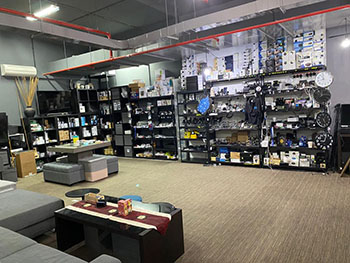Body-Worn Camera: Tactics That Will Help in Hospitals
Across the world, people enter the hospital on a daily basis as victims of shootings, stabbings, and beatings, as well as for non-violence-related medical needs. Many are admitted for short- or long-term care. In such crowded areas, violence is not an unexpected thing. Sometimes patients misbehave with staff, senior officers shouted on juniors or some non-related persons entered in hospitals and create violence.
According to a study conducted by the International Association for Healthcare Security and Safety (IAHSS), nearly 80% of hospitals need access control systems and CCTV upgrades. Healthcare administrators and security professionals need to deploy enhanced video surveillance solutions to protect patients, visitors, nurses, physicians, and staff at hospitals, offices, ambulatory centers, and long-term care facilities.
Body-worn cameras have been introduced in hospitals to improve safety for health workers. The cameras are designed to send a clear message of zero tolerance to those who abuse or attack staff at the hospital.
Benefits of BWC’S
These devices provide greater accountability on interactions between the ambulance crew and patients. Paramedics regularly place themselves in difficult and dangerous situations. Cameras helped coordinate with police colleagues to ensure action is taken following any criminal acts against staff or the trust. Body cameras help here by providing impartial and secure video footage of events encountered on the front line. The video footage is stored in a secure SD card that can later be used as admissible evidence in court.
The recordings from these cameras can be used for coaching and training, as well as help fine-tunes medical procedures. Ambulance crews could potentially benefit similarly by reviewing recordings to improve their response to situations and getting real-time feedback to help make life-saving decisions. The cameras can also be used as training for on-boarding new staff members and showing them special procedures and how to respond to them.
Paramedics are facing verbal and physical abuse while on duty, these cameras helpful for finding those people. Body-worn cameras are a popular choice in the front-line protection of staff. Paramedic staff dedicates their lives to protecting and caring for people in their times of greatest need and for any one of them to be subject to aggression or violence is completely unfair able.
Challenges faced by hospitals
- Providing better safety for patients, visitors, and staff
- Complying with government orders and security gauges
- Protecting against false claims and prosecution
- Overcoming budget pressures
- Integrating access control and video investigation frameworks
Solution
OMG body-worn cameras products
https://omgsolutions.com/body-worn-camera/
KEY BENEFITS
- Healthy, high-performing storing framework in all devices
- Live to track via a built-in GPS system
- SD memory card storage
- Live view via 4G
- Docking station
- Facial recognition
- The footage is encrypted and cannot be edited
- The footage is kept for 31 days unless a request is made to retain it for longer
- We provide device, sensor, trackers, telemonitoring, wireless technology and real-time home tracking devices and their application for clinicians
Body cameras have the potential to improve performance and satisfaction across different job types. In case studies with security staff, for instance, cameras have proven to have a calming effect on aggressive members of the public. This, in turn, has improved work satisfaction by making staff feel safer in their line of work. The video below clearly illustrates this.
If pictures are worth a thousand words, the video may be worth millions. Live-streaming capabilities in the cameras, allow doctors off-site to give medical advice to paramedics attending to complex cases on the ground, if necessary.
Hospitals are unique in security challenges specific to particular industries that are all brought together in one organization. In addition to general areas, hospitals often have restaurants, gift shops, pharmacies, holding cells for the treatment of inmates and psychiatric treatment areas all presenting unique technology requirements. As a result, the blend of OMG law enforcement security devices is often broader than with other types of suppliers. Video, access control, alarms, body-worn cameras, and other tools may be deployed and integrated together in a hospital’s security program.
Parking areas require special consideration. Being 24 -hours a day operation, hospital parking areas can experience constant activity, making suspicious behavior more difficult to detect at night. Besides preventing thefts and other crimes, hospital security guards making sure employees and patients feel secure. After a CCTV camera body-worn camera is the best option for taking video at night in low light and live streaming for control rooms.
The hospital is in many ways a private space, some analysts suggest to use body cameras during surgical operation and recorded footage could be reviewed by experienced doctors and new surgeons, and be used during medical training to help avoid errors in the future. But in Asia, there are many cases where doctors record delivery operation and upload videos on social media for getting reviews and followers, so body-worn cameras must be encrypted and health care departments have their own rules and limitations for using body cameras especially in the emergency area.
Givot said “When one is out in public there’s no expectation of privacy, so video recording in public is really not a problem. But when one is communicating with a health care provider, there is an expectation of privacy,”.
The new trial took place at Berrywood Hospital, which is run by the Northampton shire Healthcare NHS Foundation Trust. The firm Calla supplied 12 Reveal cameras, which were worn by matrons and the security team on each of the hospital’s five psychiatric inpatient wards, following training. Both staff and patients considered that the
Our Devices available in the market for the security of hospitals and for other departments
- Audio Surveillance Spy Voice Recorders
- Man Down System – Lone Worker Safety Solution
- Body Worn Camera (Digital Evidence Management)
- Mini WIFI/GPS/3G/4G Body Worn Camera (BWC058-4G)
- 3G/4G Wireless Body Camera (BWC004-4G)
- Mini Body Worn Camera with External Memory (BWC055)
- Police Body-Worn Camera (BWC004)
- Secure Mini Body Worn Camera with Encryption [No LCD Screen] (BWC059)
- Body Worn Camera, External Storage – SD Card 32GB-128GB (BWC043)
- Long Hours [16 Hrs] Recording Body-Worn Camera (BWC061)
- Secure Mini Body Worn Camera with Encryption [With LCD Screen] (BWC060)
- CCD Button Camera (BWC054)
- Mini Body Worn Camera – Super Video Compression (BWC058)
- Wearable Headset Body Worn Camera (BWC056)
- Emergency Panic Button Alarm
- Hidden Spy Camera (Home Security)
use of the cameras in an inpatient mental health setting was “beneficial”, said the researchers.
The majority of the public generally agreed on wear a body camera that they would worry about the possibility that a non-authorized, third party might gain access to their personal information, and that they would worry about future discriminations due to possible disclosure of their information. Most physicians disagreed that body cameras will disrupt the doctor-patient relationship but they would worry about the safety of their patients’ information. Overall, both the public and physicians were in favor of the implementation of the body-worn camera system, evaluating that possible benefits are more important than possible risks. The majority of the public believed that authorities should have full access to data whereas nursing staff, pharmacists, laboratory staff, and other healthcare professionals should have partial access.
Research
Now giving some research doing by some medical officers.
After trials in mental health wards, the government wants paramedics to use the cameras. In 2014, the use of body-worn cameras by nurses was first tested on two wards at Broadmoor, a high-security psychiatric hospital in Crowthorne, Berkshire. The footage provided evidence to support prosecutions following violent incidents there and a small reduction in incidents of assaults on staff was also noted. Moreover, there was a “notable reduction in antisocial and aggressive behavior”, according to a spokeswoman for the West London NHS Trust, which runs Broadmoor.
Jim Tighe, a local security management specialist at West London NHS Trust, says the cameras have made staff feel more confident. “We’ve used the footage on a couple of occasions for serious incident reviews and it’s been really helpful to clearly see and hear what’s happened. It can help reduce the length of time an investigation takes because you’ve got that independent witness,” he says.
Conclusion
So, after a long discussion, we learned that every technology has some good and bad effects, but body-worn cameras give more benefits to fewer drawbacks which can further overcome by technology. The governments should give more budget for imposing new technology in public sectors. Paramedics regularly place themselves in difficult and potentially dangerous situations. And body-cams can provide dramatic video evidence of life on the front line.
References
Anon., n.d. SALIENT. [Online]
Available at: https://www.salientsys.com/industries/hospitals-healthcare/
Department of Medical Laboratories, A., 2018 Feb. NCBI publmed.gov. [Online]
Available at: https://www.ncbi.nlm.nih.gov/pubmed/29331259
DeSilva, D., n.d. Reveal. [Online]
Available at: https://www.revealmedia.co.uk/5-ways-body-cameras-could-help-ambulance-staff
Hardy S, Bennett L, Rosen P, Carroll S, White P, Palmer-Hill S, (2017. [Online]
Available at: http://www.mhfmjournal.com/old/open-access/the-feasibility-of-using-body-worn-cameras-in-an-inpatient-mental-health-setting.pdf
Mei, T. T., FEB 1, 2019, The Straitstimes. [Online]
Available at: https://www.straitstimes.com/singapore/health/body-worn-cameras-for-scdf-paramedics
Morris, A., May 30, 2019. Express & star. [Online]
Available at: https://www.expressandstar.com/news/health/2019/05/30/ambulance-staff-to-wear-body-cameras-as-40pc-of-paramedics-attacked/
Mulholland, H., Wed 1 May 2019. SUPPORT THE GUARDIAN. [Online]
Available at: https://www.theguardian.com/society/2019/may/01/body-cameras-protect-hospital-staff-patients-violence-mental-health-wards









